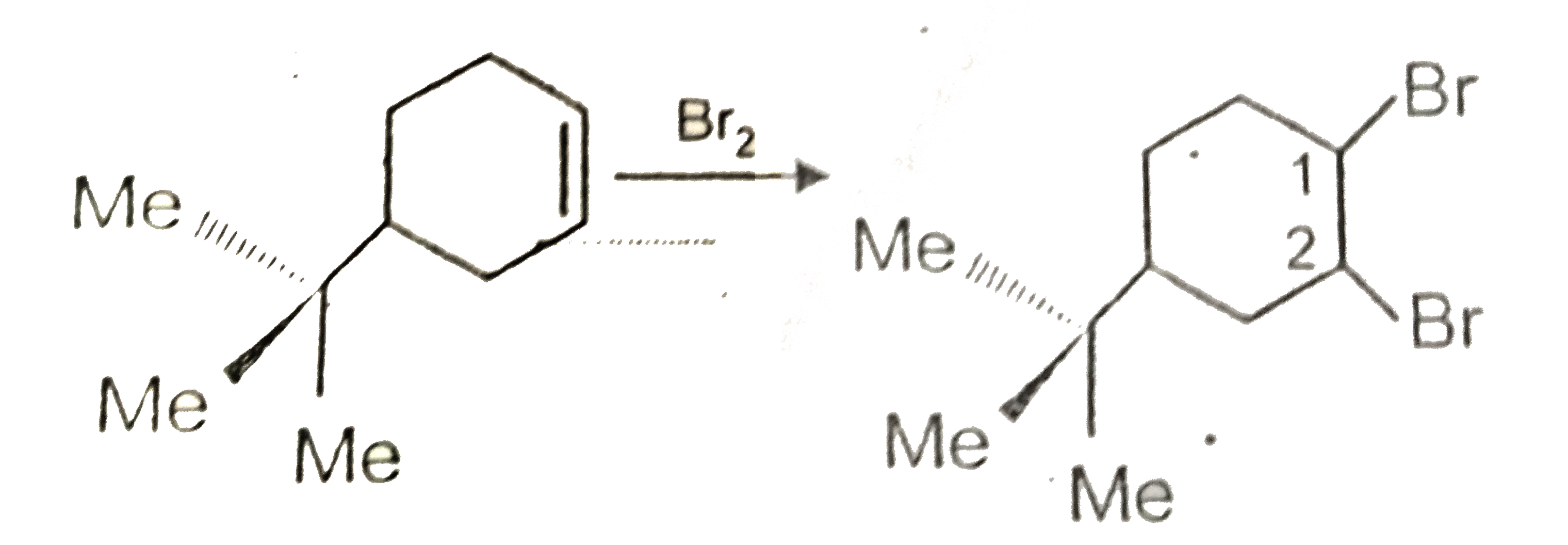1-Penten-4-yne reacts with 1 mol bromine at -80°C to produce :
4,4,5,5-Tetrabromopentene
1,2-Dibromo-1,4-pentadiene
1,1,2,2,4,5-Hexabromopentane
4,5-dibromopentyne
The correct Answer is:D
To solve the problem of what product is formed when 1-Penten-4-yne reacts with 1 mole of bromine at -80°C, we can follow these steps:
Step 1: Understand the Reactants
1-Penten-4-yne is an alkyne with a double bond (C=C) and a triple bond (C≡C) in its structure. The structure can be represented as follows:
CH2=CH−CH2−C≡C−H
Step 2: Reaction with Bromine
When alkenes and alkynes react with bromine (Br2), they undergo an electrophilic addition reaction. At low temperatures (like -80°C), the reaction tends to proceed with less rearrangement and more selective addition.
Step 3: Identify the Site of Reaction
In 1-Penten-4-yne, the presence of both double and triple bonds means that bromine can add across these unsaturations. However, since we are using only 1 mole of bromine, we can expect the addition to occur at the double bond (C=C) first, leading to the formation of a dibromide.
Step 4: Draw the Product
When bromine adds across the double bond of 1-Penten-4-yne, the product formed will be 4,5-dibromo-1-pentene. The structure can be represented as follows:
CH2−Br|CH−Br|CH2−C≡C−H
Step 5: Final Product
The final product of the reaction is 4,5-dibromo-1-pentene.
Conclusion
Thus, the product formed when 1-Penten-4-yne reacts with 1 mole of bromine at -80°C is 4,5-dibromo-1-pentene.
1-Penten-4-yne is an alkyne with a double bond (C=C) and a triple bond (C≡C) in its structure. The structure can be represented as follows:
When alkenes and alkynes react with bromine (Br2), they undergo an electrophilic addition reaction. At low temperatures (like -80°C), the reaction tends to proceed with less rearrangement and more selective addition.
In 1-Penten-4-yne, the presence of both double and triple bonds means that bromine can add across these unsaturations. However, since we are using only 1 mole of bromine, we can expect the addition to occur at the double bond (C=C) first, leading to the formation of a dibromide.
When bromine adds across the double bond of 1-Penten-4-yne, the product formed will be 4,5-dibromo-1-pentene. The structure can be represented as follows:
The final product of the reaction is 4,5-dibromo-1-pentene.
Thus, the product formed when 1-Penten-4-yne reacts with 1 mole of bromine at -80°C is 4,5-dibromo-1-pentene.
Similar Questions
Knowledge Check
Pentene-1 with HCl gives
A3-chloropentaneB2-chloropentaneC1,2-dichloropentaneD1-chloropentane.
How much gm of bromine reacts with 3.15 gm of butane -2-ene (Atomic mass of bromine=80)
View SolutionAnaerobic respiration of 1 mol of glucose produces.
View SolutionOne mole of Ethylamine when reacts with nitrous acid will produce dinitrogen gas (at 0∘C and 1 atmsopheric pressure) equal to
View SolutionIn the reaction given below , the orientation of two bromine substituents in the product is

(1) Equitorial at both C-1 and C-2
(2) Axial at both C-1 and C-2
(3 ) Equitorial at C-1 and axial at C-2
(4) Axial at C-1 and equitorial at C-2
View SolutionA compound (A) has molecular formula C5H9Cl .It does not react with bromine in CCl4. On treatment with a strong base it produces a single compound (B), (B) has a molecular formula C5H8 and reacts with Baeyer's reagent . Reductive ozonolysis of (B) produces a compound (C ) which has a molecular formula C5H8O2
On the basis of the given data what would be the structure of A ?
View SolutionA compound (A) has molecular formula C5H9CI It does not react with bromine in CCI4 On treatment with a strong base it produces a single compound (B) (B) has a molecular formula C5H8 and reacts with Baeyer's reagent . Reductive ozonotysis of (B) produces a compound (C ) which has a molecular formula C5H8O2
What would be the oxidative ozonolysis product of B ?
View SolutionA compound (A) has molecular formula C5H9CI It does not react with bromine in CCI4 On treatment with a strong base it produces a single compound (B) (B) has a molecular formula C5H8 and reacts with Baeyer's reagent . Reductive ozonotysis of (B) produces a compound (C ) which has a molecular formula C5H8O2
formation of ( B) from (A) involves
View Solution
